|
|

This chapter contains hardware installation instructions for the MGX 8250. Follow the appropriate instructions carefully to ensure successful installation.
The steps involved in the installation of the MGX 8250 are described as shown below.
Before installation, review this section for general information on the installation and placement of the MGX 8250.
A layout plan should exist for the entire network and for each card. This information comes from the site survey detailing rack/equipment positioning and specific implementation instructions. This survey includes
The initial sections in this chapter also include a review of the planning decisions that must be made before installation of the switch.
For a list of physical and electrical characteristics of the switch, see "System Specifications."
Refer to the documentation supplied with each piece of equipment for additional installation information.
Rack configuration rules for the MGX 8250 rack are as follows.
The following list contains the stacking order for modules from the bottom up (see Figure 4-1).
Optional spacers for 23-inch racks are also included.
Modules must be installed in a specific order.
1. Optional AC power assembly
2. Air intake chamber
3. Lower spacer unit or optional lower fan tray
4. Card cage
5. Upper (mandatory) cooling unit fan tray
6. Exhaust plenum
7. Optional spacers for 23-rack installation
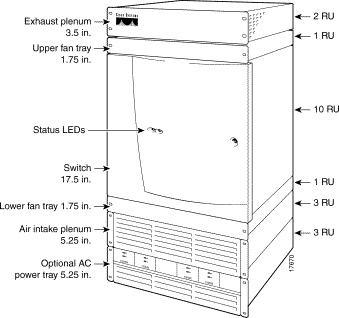
When installing the modules, observe the following rules.
 |
Caution Do not use power screwdrivers on captive screws. |
 |
Caution The rack must be securely supported. Verify that the equipment does not create a hazardous condition due to uneven mechanical loading. |
 |
Caution The rack location must allow an unrestricted air to flow in and out of the node. |
 |
Warning Before handling any cards, ground yourself to the card cage with a wrist strap. |
The installation tools are needed for installation.
The minimum distance between left and right mounting rails is 17.75 inches or 45.08 cm. The width of the modules (such as card cage and fan tray) is 17.73 inches.
If a standard 19-inch (48.25 cm) rack cannot provide this space, a 23-inch rack is necessary.
Flanges at the front of each module serve as mounting brackets in a 19-inch rack. For 23-inch racks, Cisco Systems provides special brackets. The 19-inch rack version appears in Figure 4-2.

The mounting rail locations comply with sites that require mounting on front, middle, and rear mounting rails (Figure 4-3).
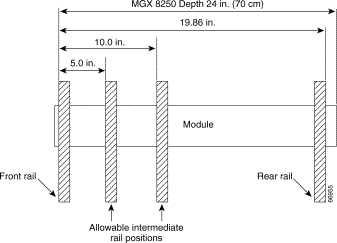
To install a MGX 8250 that is pre-installed in a Cisco rack
1. Review the "Layout Plans" section.
2. Continue to the "Install Electrical Connections" section.
 |
Caution When moving a Cisco-supplied cabinet, do not push the cabinet at its sides. Instead, grip its front or back edges. |
Cisco recommends the use of a mechanical lift to install the MGX 8250 in an open rack.
If a mechanical lift is not available, the cards and power supplies must be removed from the chassis so it can be lifted into the rack. This option is not recommended due to the possibility that a backplane pin might be bent or broken.
The following sections contain instructions to install the switch in an open rack:
 |
Warning Removing and re-installing the cards and power supplies increases the chance of broken or bent pins on the backplane. Use caution when cards are removed or replaced. Cisco Systems recommends the use of a mechanical lift for open rack installations. |
Due to the weight of the equipment, a mechanical lift should be used to install the chassis into the rack. The instructions in this section assume the use of such a lift.
Use of a lift greatly simplifies the installation process since the cards and power supplies do not need to be removed.
Step 1 Use a lift raise the chassis to the desired position.
Step 2 Insert two spacers: one on left edge and one on right edge of lower adjacent chassis. The spacers should be ~.060-inch (1/16-inch) thick, by ~2 inches by ~ 30 inches and fabricated from HDPE, aluminium or cardboard.
Step 3 Slide the MGX 8250 across the spacer and mount the chassis to the open rack.
Step 4 If this node requires the brackets for a 23-inch rack, attach them to the enclosure modules.
Step 5 Install the mandatory fan tray (1 RU, see). Note the label that says "Air Flow Direction."
 |
Note When you move the fan tray into position, make sure the back base clears the top-rear edge of the card cage beneath it. |

Step 6 Install the exhaust plenum (2 RUs).
Because the MGX 8250 chassis with installed modules is too heavy to lift, a mechanical lift should be used to install the switch into the rack.
If a mechanical lift is not available, the cards and power supplies should be removed before the chassis is installed.
This section contains instructions to remove the cards, install the chassis into the rack, and re-install the cards.
 |
Warning Removing and re-installing the cards and power supplies increases the chance of broken or bent pins on the backplane. Be careful to properly align and install the cards and power supplies. To avoid the possibility of bent or broken pins, and to simplify installation, Cisco Systems recommends the use of a mechanical lift for open rack installations. |
To install an MGX 8250 without a mechanical lift, perform the following items
1. Remove all cards and power supplies (except the PXMs) according to the following instructions:
A latch on each single-height front card secures it to the backplane.
Double-height cards have latches at the top and the bottom (see Figure 4-5).

Perform the following steps to remove a front card.
Step 1 Press the tip of a small, flat-blade screwdriver into the slot of the insertion/extractor lever until the latch springs open. For double-height cards, repeat this action at the bottom latch.
Step 2 Lift the lever to dislodge the card from the connector.
Step 3 Gently pull the card out of the card cage.
A screw at the top and bottom of the faceplate on each back card, line module, or port adapter secures the card in its backplane connector. Perform the following steps to remove a back card.
Step 1 Use a flat-blade screwdriver to loosen the two retaining screws in the faceplate.
Step 2 Simultaneously pull both extractor levers out to disconnect the card from the backplane.
Step 3 Gently pull the card out of the card cage and store it in a safe location.
This section describes how to remove the 220 VAC power supply.
Perform the following steps to remove a 220 VAC power supply.
Step 1 Remove the air intake grille: insert a flat-blade screwdriver in the access hole at the top, then rotate the screw until the spring latch opens. See "Release" in Figure 4-6.
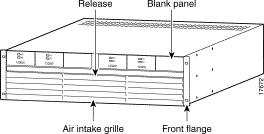
Step 2 Tilt the air inlet grille down to about a 45-degree angle, lift it out and set it aside. This action exposes the hinged door that serves as the power supply retainer bracket.
Step 3 Use a flat-blade screwdriver to unscrew the captive retainer screw in the center of the hinged door. Tilt the door down.
Step 4 Loosen the captive screw at the front-bottom of the power supply (see Figure 4-7).
Step 5 Grip the handle and remove the power supply.

Once the cards and power supplies are removed, the enclosure can be installed in the open rack.
Use the guidelines in the "Rack Configuration" section and the "Module Stacking Order" section to determine the placement of each component.
For specific instructions for each type of component, see the following steps.
Step 1 Attach the brackets for a 23-inch rack to the enclosure modules, if necessary.
Step 2 For an AC-powered system, install the optional AC power tray. Its height is three rack-mount units (three RUs is 5.25 inches or 13.34 cm). (See Figure 4-8.)
For a mid-mount installation, insert each mounting screw from the inside the power tray so that the nut is on the outside of the tray. This allows room for power supplies in either the first or last power supply trough.

While you secure the front of the power supply tray with the front screws, hold the adjacent front flange of the tray slightly to the outside so the hinged door can freely open and close. See "Front Flange" in Figure 4-8. The space between the right-angle edge of the flange and the edge of the hinged door should be about the thickness of a thumbnail.
Step 3 For a DC-powered system, install the DC-PEMs at the back of the air intake module. If you install only one DC-PEM, install it on the right. (See Figure 4-9 and Figure 4-10.)



Step 4 Install the air intake module (3 RUs). (See Figure 4-11.)
Step 5 Install the optional booster fan tray, if present; otherwise install the spacer unit (1 RU). (See Figure 4-4.) If you install a fan tray, note the label that says "This Side Up."
Step 6 Install the card cage (10 RUs). When you move the card cage into position, be sure the base of the card cage at the back fully clears the top-rear edge of the spacer unit or fan tray beneath it.
Step 7 Install the mandatory fan tray (1 RU). (See Figure 4-4.) Note the label that says "Air Flow Direction." When you move the fan tray into position, make sure its base at the back fully clears the top-rear edge of the card cage beneath it.

Step 8 Install the exhaust plenum (2 RUs).
If you install the cable manager, proceed to the "Install the Cable Manager," section before you do the tasks in the "Swapping a Primary or Redundant DC PEM with Power On." section.
This section describes how to install front and back cards. Service modules can go in any slot except reserved slots 7, 8, 15, 16, 23, 24, 31, and 32. The PXMs and optional SRM core cards occupy these reserved slots. Additionally, upper slots 9 and 10 and lower slots 25 and 26 do not have a special bus for the bulk distribution feature. For this reason, Cisco recommends that if the switch contains one or more Route Processor Modules (RPM/Bs), the first two RPM/Bs go in slots 9 and 10.
 |
Caution To prevent damage to the cards from static electricity, put on a wrist strap and connect it to any metal contact on the switch before you touch any cards. |
 |
Caution Handle the PXM1 front card very carefully to preserve the alignment of the attached disk drive. Do not drop or bump the PXM1. |
 |
Caution Inserting the cards in the correct slot is especially important for the back cards because of the potential for electrical damage. Damage to the card and backplane may occur if a service module back card is inserted into a PXM1 back card slot (7, 8, 23, or 24). If incorrect switch behavior is observed after a service module back card is accidently inserted into any of PXM1 slots 7, 8, 23, or 24, check the backplane and cards for bent or damaged pins. |
Verify the slot placement of each card before you begin installation.
Perform the following steps to re-install a front card:
Step 1 Position the rear card guides over the appropriate slot at the top and bottom of the cage.
Step 2 Gently slide the card all the way into the slot.
Step 3 Press the insertion-extractor lever until it snaps into the vertical position.
 |
Note The card should slide in and out with only slight friction on the adjacent board's EMI gaskets. Investigate any binding. Do not use force. |
Verify the slot placement of each card before you begin installation.
 |
Caution Before using the switch, verify that the daughter card type on the PXM1 corresponds to the uplink card type. Serious damage may result if the power is on and these cards are mismatched. |
Perform the following steps to install a back card:
Step 1 Make sure the two extractor levers are in the in position. As you move the card, the levers should be flush with the vertical edge of the back card.
Step 2 Gently slide the card all the way into the slot.
Step 3 Push the card into the connector.
Step 4 Tighten the two captive screws on the card faceplate to secure the card. Do not overtighten the screws.
This section contains the following instructions:
If you left the AC power supplies in the tray during installation, proceed to the "Connect 220 VAC Power to the MGX 8250." section.
Perform the following steps to re-install power supplies you removed:
Step 1 Push each power supply into the tray.
When it almost reaches the end of the slot in the tray, a slight resistance is encountered. Push the power supply slightly farther in to achieve the final position and full connector mating.
Step 2 Secure each supply to the tray by tightening the captive screw at the bottom-front of each supply.
For slots without a power supply, the hinged door on the tray should have a removable, blank panel.
Step 3 Close the hinged door and secure it with the screw at the top-center of the door.
If you removed the AC power supplies before installing the AC power tray, re-install them in the same locations they had when the switch arrived. If necessary, use the steps in the section titled "Redundancy for Service Modules" section. At the switch, the AC power receptacle is an IEC-type with a clamp.
 |
Note The AC voltage range is 200-240 VAC. |
Perform the following steps to install the power cord:
Step 1 Loosen the cable clamp around the receptacle, otherwise the plug may not properly fit.
Step 2 Firmly seat the plug. This may require you to hold the chassis with one hand while you push the plug in with the other hand.
Step 3 Tighten the clamp.
Cisco can provide AC power cords with the following types of AC wall plugs:
The DC switch uses 6 AWG (10 square mm) copper wire. For details on wire lengths, wire gauges, and grounding concerns, see "Site Preparation".
Each primary or redundant DC source connects to one or two DC PEMs in the switch. Make sure that each source comes from a dedicated branch circuit. Only a source that complies with safety extra low voltage (SELV) requirements in AS/NZ 3260 and EN60950 should connect to a DC-powered switch. The wiring for a DC-powered system is provided by the customer and must be three-wire solid or stranded copper (with insulation rated for 60 degrees centigrade).
The recommended terminal lug to be used with the DC PEM terminal block is Panduit LCAS6-10-L.
For installations where protection conduit is not required by local codes, the plastic cover visible at the bottom of Figure 4-13 is sufficient. Two phillips screws secure this cover to the PEM.
Use the visual information in Figure 4-13 and Figure 4-14 to connect the DC wiring.
Step 1 Cut the appropriate wire lengths.
Step 2 Strip the insulation back 0.25 inches (6 mm).
Step 3 With power off at both the switch and the source, attach each wire to the #10-32 lugs. See (Figure 4-14).


If necessary, you can swap out and replace either a primary or a redundant PEM with power on. To avoid possibly tripping the system circuit breaker in the process, use the sequence described in this section for disconnecting and reconnecting the system power cabling.
 |
Caution The cable connector must be disconnected at the backplane end during hot PEM insertion or removal. |
If you disconnect the cable first at the PEM, the system power cable is still hot. These hot contacts may inadvertently touch a surface of the chassis or metal connected to the chassis. If this contact occurs, the -48 VDC is shorted to the chassis, and the circuit breaker on the still-active PEM opens.
To remove a PEM with the system power on, perform the following steps:
Step 1 Turn off the circuit breaker to only for the PEM you intend to replace.
Step 2 Turn off the branch circuit at the DC source (for example, the distribution box).
Step 3 Disconnect the three DC source wires at the wiring block on the PEM.
Step 4 Locate the backplane end of the cable for the PEM you intend to replace.
Step 5 At the backplane end of the cable, loosen the captive screws on the cable bracket.
Step 6 Pull the cable bracket out approximately one inch to disconnect the cable.
Step 7 At the end of the cable connected to the PEM, loosen the jack screws and disconnect the power cable from the PEM.
Step 8 Remove the PEM.
Perform the following steps to install a PEM with the power on.
Step 1 Make sure the circuit breaker is in the off position.
Step 2 Insert the PEM and tighten the captive mounting screws.
Step 3 Connect the system power cable first at the PEM.
Step 4 Connecting the backplane end of the system power cable to the backplane requires some dexterity, especially if the cabling around the system power cable is dense. Grasp the cable bracket at the captive screws and gently push the bracket straight in.
Step 5 Tighten the connector screws.
Step 6 Attach the three DC source wires at the wiring block on the PEM.
Step 7 Turn on the DC power at the circuit branch source.
Step 8 Turn on the circuit breaker of the PEM.
The version of the MGX 8250 powered by either a single or redundant 110 VAC power supply is shown in Figure 4-15. The version shown has the optional door installed.
 |
Note The system is limited to using cards from Release 1.3 and earlier. Cards in future releases will not supported by this system. |
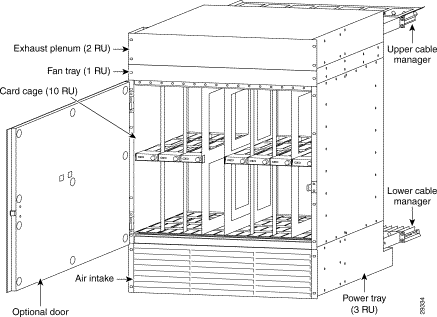
To remove and replace cards in the MGX 8250 low-profile AC version, see "Install the MGX 8250 without a Mechanical Lift (Optional)" section.
 |
Note The card cage for the MGX 8250 low-profile AC version is identical to the standard MGX 8250 card cage. |
The 110 VAC power supplies are accessed from the rear of the unit. The front grill cannot be removed on this node.
Perform the following steps to remove a 110 VAC power supply.
Step 1 Turn off the power switch on the power supply.
Step 2 Disconnect the AC input power cable from the power supply.
Step 3 Remove the DC power cable from the power supply side (see Figure 4-16). Leave the other side attached to the motherboard.
Step 4 Use a Phillips screwdriver to remove the screw at the rear of the unit (see Figure 4-16).
Step 5 Gently pull the power supply from the case toward the rear.
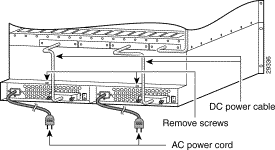
Perform the following steps to replace a front card:
Step 1 Slide the power supply into a vacant position and secure with the screw with a Phillips screwdriver (see Figure 4-16).
Step 2 Connect the DC power cable to the power supply. Verify that the connectors are firmly seated.
Step 3 Secure the cable connector with the two connector screws using a Phillips screwdriver.
Step 4 Connect the AC power cable to the power supply.
Step 5 Turn the power switch on the power supply to its on position.
After the system has been mounted, connect the fan power cable to the mother board and to the fan power connector on the fan tray. Route the power cable as shown in Figure 4-17.

The rear of a MGX 8250 low-profile DC version is shown in Figure 4-18. This illustration shows
Up to three of these units can be placed in a standard 7-foot rack. The low-profile system is 15 RU high.
Because only a single fan tray is available, the MGX 8250 low-profile system limits the type and number of cards that can be installed to a maximum total power dissipation of 1000W.
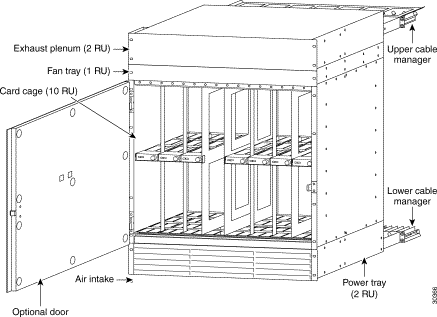
Adding and removing cards in the card cage for the low profile DC version of the MGX 8250 is identical to the procedure described in the "Install the MGX 8250 without a Mechanical Lift (Optional)" section.
To install and remove cards:

This cable manager consists of
The cable management system is shown in Figure 4-20.
Perform the following steps to attach the mounting brackets:
Step 1 Hold the bracket with one hand and position it so the lower flange fits inside the card cage wall.
Make sure the screw hole on the bracket aligns with the screw hole on the card cage.
Step 2 Drive in the screw.
Step 3 Use the provided 10-32 sized screws to install the cable managers.
The cable managers must be oriented so that the cable channels on the top cable manager are on top, and the cable channels on the bottom cable manager are on the bottom (see Figure 4-20).
 |
Note Fiber optic cabling and copper cabling take different paths on the cable manager. Use the cable channels for the copper cabling, but run the fiber optic cables over the sheet metal portion. |

Copper-based data cables from the back cards run up or down to the cable manager and pass through the channels then run to either the left or right side of the rack. Fiber optic cables pass over the sheet metal portion. The cables subsequently go to the related equipment (for example, CPE). The view in Figure 4-21 shows only the cable manager on top.

This section describes the system power cables and how to install them.
A system power cable (see Figure 4-22) carries current from either a DC PEM or AC-DC power module to the backplane. The cable is the same for AC and DC power systems. When installing the power cable, the following notes should be observed.
See Figure 4-23 for an AC-powered system and Figure 4-24 for a DC-powered system.

The following procedure should be followed when installing the system power cables.
Step 1 With the narrow row of pins in the D-connector on the bottom, use two hands to slip the larger connector through the access hole at the base of the card cage.
Step 2 Move the connector straight toward the backplane so you can guide it through the second, internal guide.
When you have fully seated the D-connector in the backplane connector, the captive screws on the frame are clearly aligned with the threaded holes on the chassis.
Step 3 Tighten the captive screws only enough to secure the connector. Do not apply much torque. Do not use a power screw driver.
Step 4 Insert the D-connector without the frame in J1 on the power assembly
Step 5 Tighten captive screws only enough to secure the connector. Do not use a power tool.
If you need to swap a DC PEM in a redundant system with the power on, see the "Redundancy for Service Modules" section for instructions.
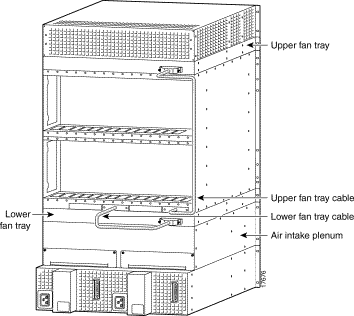

This section describes the fan power cables and how to install them.
The fans receive power from the backplane through a fan power cable (see Figure 4-25). To reach the backplane connector, the fan power cable D-connector passes through an outer hole at the base of the card cage.
At the fan-tray end of the cable, the D-connector plugs into J1.
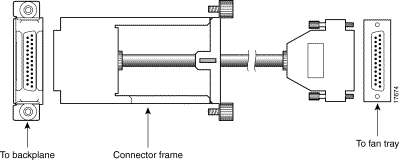
Note that the holes for the system power cabling alternate with the smaller holes for fan power. From left to right, the sequence of access holes is
1. System power
2. Fan power
3. System power
4. Fan power. Use the fan power access hole on the far right for the upper fan tray.
Illustrations of the card cage area with the cabling holes for AC- and DC-powered systems are shown in Figure 4-26 and Figure 4-27.
Perform the following steps to install the fan power cabling:
Step 1 With the narrow row of pins shown in in the D-connector on the bottom, use two hands to slip the framed connector through the access hole at the base of the card cage. Move the connector straight toward the backplane so you can guide it through the second internal guide.
With the D-connector fully inserted in the backplane connector, the captive screws on the frame are clearly aligned with the threaded holes on the chassis.
Step 2 Tighten the captive screws only enough to secure the connector. Do not apply much torque, and do not use a power screw driver.
Step 3 Insert the D-connector in J1 on the fan tray and tighten the captive screws only enough to secure the connector. Do not use a power screw driver.
Step 4 For the mandatory fan tray, position its power cable to run through the channel formed by the mounting bracket on the right.


Before applying power to the MGX 8250, check the following items:
1. Switch has proper grounding.
2. AC or DC power sources are correctly installed.
3. All cards are locked in the correct slots.
4. All cables are secure.
5. Control terminal is connected.
After the preceding checks, turn on the power. Check the following items:
1. At the front of the unit, the status light on the PXM1 should be green.
2. For an AC-powered system, the AC and DC LEDs on each power supply should be green.
3. For a DC-powered system, the DC OK LED should be on.
4. After each service module comes up, the status LED should show that the card is in standby.
5. When power is turned on, make a visual check to verify that all fans are running.
6. After the system comes up, enter the dsppwr command.
 |
Note Neither the AC power supplies nor any other components have test points for checking power supply voltages. For a visual check, observe whether the AC OK LED and DC OK LED are lit. |
 |
Note If you remove and reseat a back card or change it for another card, reset the related front card. |
| Description | Parameters |
|---|---|
Interfaces | Eight T1 or E1 T3 with optional SRM module Up to 5760/4608 (E1/T1) G.711 channels per MGX chassis |
Voice Coding/Compression | PCM (G.711) ADPCM (G.726) CS-ACELP (G.729a/b) When mixing compression types, the overall capacity varies between 145 and 240 channels per VISM. |
Voice Activity Detection | Configurable threshold on a per-channel basis |
Echo Cancellation | Per G.164, G.165, and G.168, programmable up to 128 msec |
Fax and Modem Transmission | Using PCM connection, 240 channels per module |
PCM Encoding Types | mu-law or a-law encoding End-to-end conversion available |
Channel Gain Control | -8 dB to +6 dB |
Quantizing Distortion Added | 2.5 quantizing distortion units (QDUs) with 32-kbps ADPCM over one hop plus 0.7 QDUs with digital loss packet assembler/disassembler (PAD) (mu-law or a-law) |
Nominal Transmission Loss | 0 dB at 1 kHz |
Power Consumption | 60W (estimated) |
Weight (including back card) | Approximately 1.74 lb |
The wiring on the Cisco MGX 8250 backplane requires you to consider the conversion sequence and other details when you convert single-height slots to double-height slots. One slot conversion means that you convert four single-height slots to two double-height slots. Be aware of the following before you convert the slots:
With a factory-installed MGX 8250 node, the single- and double-height cards reside in the preassigned locations. See Figure 4-28 for an illustration of an enclosure that shows installed cards and center guide modules. Certain slots have a small, L-shaped bracket holding in the card. All instances of this bracket are the card slots immediately to the right of an enclosure wall (or bulkhead). The system has three such brackets.
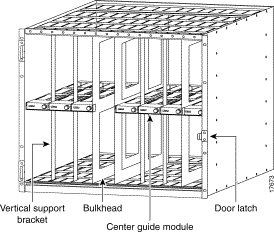
Each center guide module is secured by either a vertical support bracket or a simpler support bracket. Most center guide modules rely on the vertical support bracket. Three locations use the small support bracket: at the left wall of the card cage and at the bulkhead to the right of slot 8 or slot 14. For an illustration of a center guide module with support bracket, see Figure 4-30. For an illustration of a center guide module with vertical support bracket, see Figure 4-29.
 |
Warning Use extreme caution when completing the following steps with the system power turned on. |
Perform the following steps to convert four single-height slots to two double-height slots in an operational system:
Step 1 Remove the cabling from the back card unless the back card applies to the double-height configuration after the conversion.
Step 2 Remove the back card.
Step 3 Remove the front card.
Step 4 Repeat steps 2 and 3 for every other single-height module you remove.
Step 5 Rotate the screw that holds in the vertical center guide module.
Where either the left wall of the card cage or a bulkhead exists on the left of the single-height card slots, a simple, L-shaped bracket holds in the center guide module.
Step 6 If the center guide module has either type of wall to the left, unscrew the track attached to the wall. If necessary, remove cards to unscrew it.
Step 7 Remove the vertical support bracket by moving it up and down until you can take it out. A hole becomes visible in the center guide module for inserting a screwdriver.
Step 8 Insert a screwdriver and loosen the long screw that holds in the center guide module.
Step 9 Remove the center guide module.
Step 10 Install the double-height front card and back cards as needed.
A simpler situation exists when you install a new MGX 8250 in a non-Cisco rack or an existing Cisco cabinet—unscrew the center guide module and remove it. If the enclosure has the optional front door, blank faceplates are not necessary. With no door, you must install a blank faceplate if you create two double-height slots but install only one card.


![]()
![]()
![]()
![]()
![]()
![]()
![]()
![]()
Posted: Sat Sep 7 06:46:52 PDT 2002
All contents are Copyright © 1992--2002 Cisco Systems, Inc. All rights reserved.
Important Notices and Privacy Statement.